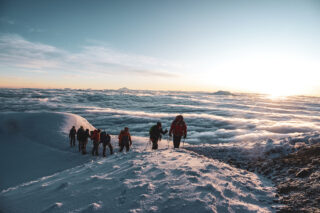
Outrageous Ecuador
Drawing on our years of experience in successfully completing Chimborazo climbs, our LHO expedition to the furthest point on Earth is expertly designed to develop your skills for a safe ascent. This journey features no fewer than four iconic mountains, including the legendary Cotopaxi, ensuring proper acclimatisation for summits above 6,000 meters. Beyond the Mount Chimborazo climb, this adventure also immerses you in the vibrant culture of Ecuador, offering an unforgettable experience for those seeking a Chimborazo guided climb while exploring one of the world’s most remarkable landscapes.

TRIP TYPE
Climbing and Mountaineering

DURATION
10 Days

DESTINATION
Ecuador
1
Includes four summit climbs: Rucu Pichincha, Iliniza Norte, Chimborazo, and one of Cotopaxi, Cayambe, or Antisana—chosen based on the most favourable conditions.
2
Relive the adventure with exclusive expedition photography captured by your LHO Team Leader, included as part of our standard offering.
3
Guided by a specialised LHO Expedition Coordinator and certified IFMGA guides, ensuring a seamless, safe experience, with full support on and off the mountain.






2026
DATE & STATUS
PRICE
TEAM LEADER
AVAILABILITY
WHAT'S INCLUDED IN THIS TRIP
WHAT'S NOT INCLUDED IN THIS TRIP
DAY 1: WELCOME TO BEAUTIFUL QUITO
Upon your arrival at Quito International Airport, you’ll be met by our transfer partners who will pick you up and drive you in our private shuttle to the hotel. Your LHO Team Leader will be at the hotel to greet you. Once you’ve settled in, your gear will be checked to ensure you have everything you need.
If you arrive early, you can explore the lively town of Quito nestled between the high mountains of the Andes. There is no shortage of coffee shops, bars, and markets to explore. The old town is particularly special and is designated as a UNESCO World Heritage site because of its layers of architectural history that date back centuries. Your LHO Team Leader will send you a message with more recommendations of things to do closer to your trip date.
On your first night, we’ll gather for a team briefing and dinner at a trendy Quito restaurant. Sometimes our dinners are hosted at our hotel if we feel that it would give everyone more time to prepare their belongings and get enough rest for the adventure ahead of us. This will be your first chance to meet fellow participants and your lead local guides. It’s also an opportunity to learn about the exciting experience we’ve prepared for you and ask any questions you may have.
DAY 2: RUCU PICHINCHA HIKE
Distance: 9.8 KM | Ascent: 759 M | Descent: 759 M | Max Altitude: 4,645 M
Our first day in the mountains starts after breakfast. We’ll depart from the hotel in the direction of the cable car on the eastern side of the city. Quito is already at 3000 meters, so for those of us who arrived from sea level, we’ve already been acclimatizing since we landed. Our aim for the day is to push higher into altitude and then return to Quito to rest and recover. Our summit is called Rucu Pichincha and stands at an impressive 4,696 meters. For locals, this is a daily stroll or a trail run, but for us, this is a serious achievement because of the altitude our bodies are used to operating at.
The trail to Rucu starts from the top of the cable car at 4000 meters. From there we’ll follow a well-marked trail over a series of hills largely characterized by short grass vegetation. On a clear day, it is possible to see the summit of Rucu from the very start of the trail. As we approach the base, the trail goes around the rocky ridge and connects to a series of switchbacks on the southern slopes. This is the final stretch to the summit. Achieving the summit requires a slight scramble over some easy rocks. From the top, we can see all of Quito, the full Pichincha range of active volcanoes, and Cotopaxi.
After taking it all in and snapping a few summit photos, we’ll make our way down to the cable car. Lunch will be served at a local restaurant just before arriving at the cable station. Dinner will be hosted by your LHO Team Leader and local guide at a trendy restaurant in town. Our night will be spent at the same hotel in Quito.
DAY 3: NORTH ILLINIZAS HIKE
Distance: 10.6 KM | Ascent: 1,131 M | Descent: 1,131 M | Max Altitude: 5,080 M
We’ll get an early start heading south along the Pan American highway. This will be our first opportunity to see the vast number of volcanoes that dot the Ecuadorian landscape, including Cotopaxi, Illinizas, and Corazon as we depart from the cityscape into the Andean countryside.
Although North Illinizas may appear small relative to Cotopaxi and Chimborazo, it is a major achievement in its own right. The climb to the top starts in the upper grasslands before connecting with the bare ridge that we’ll be following all the way to the top. We’ll be stopping for lunch at the mountain refuge just before the summit ridge that connects both Ilinizas North and the more technical Ilinizas South.
From the refuge onwards, we’ll be faced with a combination of scrambling and trekking until we reach the top. Although we rarely need technical gear on this ridge, we’ll still be prepared with our harnesses and helmets on at all times. Sometimes snow and ice can make certain exposed sections a little challenging, and it’s always best to be prepared. The summit itself is quite narrow and exposed, so our time at the top will be limited.
The descent from the summit takes a different path down a rocky scree that reconnects with the grassland trail. This is a full day of trekking and usually ends after sunset. Although we aim to have dinner at the hotel as soon as we return to Quito, we may grab some empanadas on the road, so our team can rest as soon as we arrive at the hotel.
DAY 4: COTOPAXI, CAYAMBE, OR ANTISANA BASE CAMP
Distance: 0.8 KM | Ascent: 259 M | Descent: 12 M | Max Altitude: 4,851 M
Our first choice of mountain on this expedition for the second half of the itinerary is Cotopaxi. Unfortunately, Cotopaxi is an active volcano and has been regularly erupting in recent years. That’s why we have included Cayambe and Antisana as alternatives. They are all within 100 meters of altitude from one another and have similar technical profiles and challenge levels, making each climb an independent achievement in its own right.
Your LHO Team Leader and local IFMGA-certified guides will observe conditions and weather on all three summits to determine which one is safe, and feasible, and offers high potential for summit success. Regardless of which summit, the following description of Cotopaxi is a similar representation of both Cayambe and Antisana as well.
After breakfast, we’ll check out from the hotel and board our private bus. This will be the last departure from Quito until our return at the end of our trip. The transfer takes about 2 hours, and we’ll be stopping for a hot lunch on the way. There is a check-in procedure that has to take place at the entrance to the national park before we can continue our journey to the trailhead. The walk to the base camp isn’t far at all; it usually takes approximately 30 minutes. If our destination is Antisana, we don’t have to walk at all, as the cars can reach the campsite directly.
We’ll check in to our basic mountain hut accommodation (tents in the case of Antisana) and then make our way up to the snow line with our technical gear for some glacier schooling on the use of crampons, ice axes, and other technical gear. Glacier school will be brief and focus on only what is necessary to climb safely. After that, we’ll return to our accommodation for dinner, a summit briefing, and some rest.
DAY 5: COTOPAXI, CAYAMBE, OR ANTISANA SUMMIT
Distance: 4.6 KM | Ascent: 1,011 M | Descent: 1,011 M | Max Altitude: 5,897 M
Depending on the mountain conditions and the pace of the team, we’ll be departing base camp in the direction of the summit anytime between 11 pm and 1 am. The trail starts on dry ground, with crampons usually not needed for the first 300 vertical meters. Once crampons are on, the trail winds up the glacier with a combination of inclines, flats, ridges, and switchbacks, all while navigating an intricate network of crevasses.
As we approach the crater rim, the ascent becomes steeper. In some instances, it can reach close to 30 degrees. It is the most challenging section and requires strength of will to overcome. Your LHO Team Leader and guides will be there to encourage you and keep the motivation going. Reaching the summit of either one of these three volcanoes is nothing short of spectacular. The views are unparalleled anywhere in the world, and jetting out of the skyline in the distance is the gigantic Chimborazo, ever reminding us that the best is yet to come.
The summits of all three mountains are quite wide, and in good conditions, we can take our time to enjoy it. The descent is a retracing of our steps all the way back to the hut where a full breakfast awaits. We’ll then proceed to pack our stuff, walk the short trail to our bus, and head in the direction of our Hacienda on the outskirts of Riobamba and at the base of Chimborazo.
We’ll stop on the road for a hot lunch and an ice cream. The Hacienda is a luxurious ranch that is typically used as a country retreat in Ecuador. Our Hacienda includes a spa, garden, restaurant, bar, and fireplace area. It’s been carefully selected to contrast our mountain experience with a comfortable space to recover in. This will be our home for at least two nights. Dinner will be at the restaurant of our accommodation.
DAY 6: BANOS: OUR KIND OF REST DAY
After breakfast, we’ll head out for a fun day in the resort town of Banos. There, we’ll have the opportunity to visit the Rio Verde, located in the UNESCO World Heritage site within the Sangay National Park. We’ll also do a short walk down to the second-highest waterfall in Ecuador, the Pailon Del Diablo. There are also opportunities to bungee jump and zip-line for those of us who are up for it. For those of us who’d prefer a more traditional rest day, there are loads of coffee shops, market streets, and restaurants to explore and enjoy. You can also book an afternoon spa massage for when we get back to the Hacienda. Lunch will be in the town center. We’ll head back to our accommodation in the early afternoon to take it easy before dinner and the summit briefing.
DAY 7: OFF TO THE FURTHEST POINT ON EARTH
Distance: 2.7 KM | Ascent: 677 M | Descent: 0 M | Max Altitude: 5,520 M
Depending on mountain conditions and how the team is feeling, we may choose to either rest for one additional day or make our way to Chimborazo base camp. The decision will be taken the night before by the guides and your LHO Team Leader. If we do stay for an additional rest day, then we’ll be remaining at the Hacienda for the day. If we decide to move to Chimborazo base camp, then we’ll depart after breakfast. We’ll stop for Lunch on the road to the national park. After checking in to the park, we’ll continue on the road that leads to the parking lot at the foot of the mountain’s west face. There is a nearby refuge that can sometimes be used in the event that conditions on the mountain are unclear. Normally, the aim is to ascend from the parking lot directly to high camp.
The route to high camp starts with a dry trail that quickly gets covered in snow. Usually, it is not necessary to put on crampons at this point, but if conditions are particularly icy, we may need to put them on. From the snow line, we follow a wide ridge that connects with a plateau at 5,100 meters. On the plateau are three fixed tents that makeup Chimborazo high camp. After checking in, we’ll make our way to the mess tent for dinner and a summit briefing. After that, we’ll try to get some rest in the team common tent before our ascent to the summit of the furthest point on Earth.
DAY 8: CHIMBORAZO SUMMIT DAY
Distance: 6.3 KM | Ascent: 785 M | Descent: 1,461 M | Max Altitude: 6,268 M
If we decided to remain at the Hacienda for a second rest day, then this day would be our trek to the base camp. (See the previous day’s itinerary for details). If we had already decided to make our way to the base camp, then this is our summit night which begins between 11 pm and 1 am, depending on mountain conditions and the pace of the team. The trail immediately starts on the glacier with the traverse of the Castillo. This section is the most technically demanding part of the night because it sits on a snowy ridge that can be tricky to navigate and requires sure-footedness to cross safely. This section lasts for about one hour before it connects with the wider west face of the mountain.
The direct ascent to the summit starts at the end of the Castillo ridge with a sustained climb all the way to the Ventimilla summit (6228m), Chimborazo’s small summit. This section is primarily switchbacks on the snow and ice. The most challenging part is to achieve the Ventimilla summit. If conditions and timing don’t permit us to go further, this can sometimes be our final summit. If it is possible to continue on to the 70-meter higher summit, then we’ll cross the summit plateau for the final two switchbacks to reach the top. Time spent on the summit will be dictated by conditions. We’ve had days where it was possible to spend a lot of time and other days when we could barely snap a photo before the shivers kicked in.
Once we start heading down, it’s a direct descent to the base camp for our second breakfast before continuing down to the car. If we attempt Chimborazo on day 8, then we’ll be spending this night at the Hacienda again, where the spa awaits!
DAY 9: CHIMBORAZO DAY (SUMMIT)
If we trekked to the base camp on the previous day, then we’ll be attempting to summit Chimborazo on this day. (See the previous day’s itinerary for details). After returning to the foot of the mountain from the summit, we’ll head back to Quito directly. If we had attempted the summit on the previous day, then we’ll be heading back to Quito from the Hacienda. Regardless of our starting point, we’ll be having lunch on the road with a farewell dinner hosted by your LHO Team Leader and local guides in Quito after checking in and having a hot shower!
DAY 10: THE BITTERSWEET END TO AN EPIC ADVENTURE
The final day is dedicated to airport transfers. Breakfast is included at our hotel. Team members will be shuttled to the airport depending on flight times. Please be sure to communicate the correct flight times when you fill out your Team Details Form prior to this experience. Please make sure to communicate any changes to your LHO Team Leader as early as possible to ensure that arrangements are made.

OUR COMMITMENT
We are dedicated to ensuring that everyone involved in our services receives a fair living wage in their respective countries. We invest in our team members, fostering upward mobility within the adventure travel industry, expanding educational opportunities, and offering support wherever we can. By joining an LHO adventure you are directly impacting the incredible people and the remote communities that make these life-changing experiences possible.
LEARN MOREHEALTH & SAFETY GUIDELINES
We do our best to ensure your wellbeing on LHO adventures. That's why the facilities we use throughout our trips are required to meet our health and safety standards. We also follow the laws and protocols of every country that hosts our adventures. This extends to national regulations requiring Covid-19 testing, vaccination certificates, mask wearing or any other local guidelines that may apply. Contact us for the most up to date protocols related to your destination.
LEARN MOREHow hard is it to climb Chimborazo?
Although the route is not technically demanding, climbing Chimborazo is a serious high altitude challenge. The mountain features a relentless inclined slope that requires both strong physical conditioning and mental commitment. The Chimborazo climb difficulty comes more from the altitude and endurance required than from technical terrain.
Acclimatisation is essential for success. That’s why on Life Happens Outdoors expeditions, we include three other summits before the Mount Chimborazo climb to help prepare your body for the altitude. One of these peaks is Cotopaxi, which also serves as a major goal and training step within the expedition.
However, because Cotopaxi is a live volcano, it occasionally experiences seismic activity that may prevent climbing. In such cases, we adapt the itinerary and divert to another major summit such as Cayambe or Antisana, ensuring both safety and continued acclimatisation.
How long does it take to climb Chimborazo?
Climbing Chimborazo is typically done over two days and one night. The first day involves a trek to base camp, followed by a summit push and descent on the second day. Most teams take between 5 and 8 hours to reach the top of Mount Chimborazo, depending on pace and conditions, with the aim of returning to base camp by no later than 10:30 am. After this time, snow conditions on the traverse during the descent can become too soft and potentially dangerous.
Due to the mountain’s volatile weather patterns, Life Happens Outdoors allocates three days specifically for the Chimborazo climb within the expedition. This allows for greater flexibility and improves the chances of finding a safe and successful weather window to reach the summit.
How hard is it to climb Cotopaxi?
Climbing Cotopaxi is just as physically demanding as climbing Chimborazo, but there are a few key factors that make it slightly more accessible. One of the biggest advantages is the ease of access to the base camp, which is located just 30 minutes from the road. This reduces the approach time and overall fatigue before the climb even begins.
The Cotopaxi mountain climb also features a route where the steep incline is broken up by gentler slopes and flatter sections, giving climbers brief moments of relief during the ascent. Additionally, Cotopaxi is slightly lower in altitude than Chimborazo, reaching just shy of 6000 meters, which can make a notable difference in how your body responds at elevation.
While the Cotopaxi climb is still a serious high altitude challenge, these factors help make it a more approachable summit for those with strong fitness and proper acclimatisation.
How long does it take to climb Cotopaxi?
It takes two days and one night to climb Cotopaxi. The first day is relatively short and includes a 30 to 45 minute trek from the road to the base camp. The summit push begins in the early hours of the second day, with most teams taking between 6 to 8 hours to reach the top of the Cotopaxi volcano climb.
The descent typically takes another 2 to 4 hours, depending on the pace and the condition of the glacier. Overall, the Cotopaxi mountain climb is a fast and intense experience that requires strong physical preparation and good acclimatisation, even though the approach is shorter than many other high altitude climbs.
When is the best time to climb Chimborazo?
Thanks to their location along the equator, both Chimborazo and Cotopaxi can be climbed year round. However, climbing Chimborazo comes with the unique challenge of unpredictable weather at high altitude. Conditions can shift dramatically, and it is not uncommon to encounter severe storms and perfect weather within just a few hours.
Because of this variability, Life Happens Outdoors includes additional days in our Chimborazo climb itinerary to allow flexibility and improve the chances of securing a good weather window for the summit push. While there is no single best season, having extra time built into the schedule is key to making a safe and successful ascent.
Are Chimborazo and Cotopaxi suitable climbs for beginners?
Yes, both Chimborazo and Cotopaxi are suitable for first timers from a technical perspective. Neither climb involves complex climbing grades, and only entry level skills are required, all of which are taught as part of the expedition. If you are wondering can you climb Cotopaxi or can you climb Mount Chimborazo without prior mountaineering experience, the answer is yes.
However, due to the high altitude and physical demands of these peaks, we strongly recommend having some previous experience with altitude trekking before attempting the Chimborazo climb or Cotopaxi climb. Familiarity with how your body responds to elevation can make a significant difference in your overall experience and chances of success.
What skills are needed to climb Chimborazo and Cotopaxi?
The Chimborazo climb and Cotopaxi climb require basic mountaineering skills, but nothing beyond entry level. You will need to know how to use crampons, handle a mountaineers ice axe, and walk in a rope party on physically demanding but technically straightforward terrain.
All of these skills are taught as part of the training included in the Life Happens Outdoors expedition. Whether you are preparing to climb Cotopaxi and Chimborazo for the first time or looking to build confidence in a high altitude environment, our itinerary ensures you are equipped with everything you need for a safe and successful experience.
How fit do I need to be to climb Chimborazo and Cotopaxi?
This is one of the most physically demanding experiences we offer. By the end of the expedition, you will have summited four mountains, two above 5000 meters and one above 6000 meters. That is a major physical achievement and a true test of endurance and commitment.
To take on the Chimborazo climb and Cotopaxi climb, joiners should already lead an active lifestyle and be willing to train specifically for this challenge. We recommend preparing with at least four focused training sessions per week in the months leading up to the expedition. A strong foundation in cardiovascular fitness, muscular endurance, and hill or trail hiking will help you perform well and enjoy every step of this high altitude journey.
Where do we sleep during the Chimborazo and Cotopaxi expedition?
During the Chimborazo and Cotopaxi expedition, accommodation is carefully chosen to balance comfort, cultural experience, and recovery throughout the journey.
We spend three nights in a comfortable hotel in Quito, offering a chance to rest and adjust before and after the climbs. Four nights are spent in beautiful haciendas, traditional countryside ranches selected for their high standards, warm hospitality, and cultural value. These stays provide a unique connection to Ecuadorian heritage while offering a great environment for recovery during the midpoints of the itinerary.
There is also one night in the Cotopaxi mountain lodge, a dorm style accommodation nestled in the mountains, and another night at Chimborazo base camp, where we stay in a shared dorm style dome tent. Together, these accommodations provide a well rounded and supportive experience for anyone preparing to climb Cotopaxi and Chimborazo.
Is Ecuador a safe country to visit as a tourist?
Yes, Ecuador is generally considered a safe country to travel in, especially in the regions we visit during the Chimborazo and Cotopaxi expedition. Like any destination, it is important to take standard travel precautions, particularly in large cities or crowded areas.
The areas we explore, including Quito, national parks, and rural regions around Cotopaxi and Chimborazo, are well established trekking and climbing destinations that attract international mountaineers year round. Our team manages all logistics, accommodation, and transfers to ensure you feel safe, supported, and comfortable throughout your journey.
If you have any concerns before you travel or want more details about specific locations on the itinerary, feel free to reach out to our team directly. We are here to make sure your adventure is both memorable and worry free.
PAYMENT PLANS AVAILABLE
FROM £4,890
DOWNLOAD YOUR TRIP GUIDEBOOK
INQUIRE NOW
This adventure is only available as a private trip and is customized to your requirements, experience and skill level. To get started, please fill out the form below. We’ll be in touch soon to put it together for you.
"(Required)" indicates required fields
CONTACT US
We’re passionate about guiding you to epic adventures and beyond. If you have any questions at all, don’t hesitate to reach out. We’d love to hear from you.

